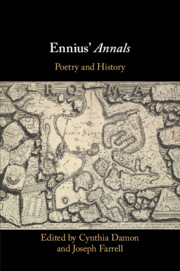Book contents
- Ennius’ Annals
- Ennius’ Annals
- Copyright page
- Dedication
- Contents
- Contributors
- Abbreviations
- Introduction: History and Poetry in Ennius’ Annals
- I Innovation
- II Authority
- Chapter 4 Allegory and Authority in Latin Verse-Historiography
- Chapter 5 Reading Ennius’ Annals and Cato’s Origins at Rome
- Chapter 6 Looking for auctoritas in Ennius’ Annals
- Chapter 7 Ennius’ Annals as Source and Model for Historical Speech
- III Influence
- IV Interpretation
- Afterword
- Works Cited
- General Index
- Index Locorum
Chapter 5 - Reading Ennius’ Annals and Cato’s Origins at Rome
from II - Authority
Published online by Cambridge University Press: 10 April 2020
- Ennius’ Annals
- Ennius’ Annals
- Copyright page
- Dedication
- Contents
- Contributors
- Abbreviations
- Introduction: History and Poetry in Ennius’ Annals
- I Innovation
- II Authority
- Chapter 4 Allegory and Authority in Latin Verse-Historiography
- Chapter 5 Reading Ennius’ Annals and Cato’s Origins at Rome
- Chapter 6 Looking for auctoritas in Ennius’ Annals
- Chapter 7 Ennius’ Annals as Source and Model for Historical Speech
- III Influence
- IV Interpretation
- Afterword
- Works Cited
- General Index
- Index Locorum
Summary
This paper investigates the largely inaccessible ancient audiences of early Roman epic and historiography, using points of intersection in our evidence for Ennius’ Annals and Cato’s Origins to consider each work’s audience in relation to the other’s. My means of approach are two. First, I explore differences in how Cicero responds to each of those works, with glances across to his surviving responses to Fabius Pictor’s history of Rome, finding that Cicero frequently cites the Annals to illustrate the forging and articulation of Roman ethical identity at exemplary moments in the past, but neither he nor any other source cites Cato or Fabius for any such purpose. Second, I consider the distribution of collectives across the surviving fragments of both works. Terms for the Roman collective are relatively abundant in Ennius’ Annals, and that collective is featured in heroic action, but in the Origins the Roman collective is much less obtrusive than might have been expected in a work notorious for suppressing the names of more recent historical leaders. The two findings suggest that it was the Annals that had the broader appeal, the readier ability to speak to and for Romans across the board.
Keywords
- Type
- Chapter
- Information
- Ennius' AnnalsPoetry and History, pp. 107 - 124Publisher: Cambridge University PressPrint publication year: 2020
- 1
- Cited by

